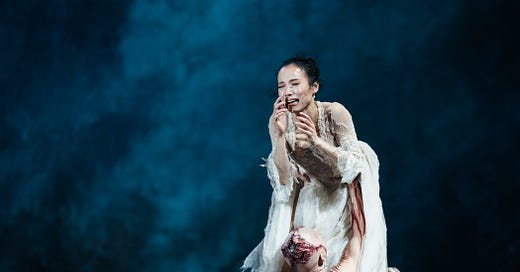A tragic, gripping "Frankenstein" at the San Francisco Ballet
Liam Scarlett's version of Mary Shelley's classic explores the terrible consequences of a life without love.
Frances Chung and Wei Wang in Scarlett's Frankenstein // © San Francisco Ballet, photo by Lindsey Rallo
Frankenstein is an extremely dark tale. But the late choreographer Liam Scarlett’s setting of Mary Shelley’s groundbreaking 1813 novel, now running at the San Francisco Ballet, manages to be both tragic and radiant, remaining faithful to Shelley’s heartbreaking story while illuminating it with gorgeous dancing. Story ballets can be clunky—the fit between the left-brain nature of narrative and the abstraction of movement is inherently tricky—and it’s hard to imagine a more story-driven ballet than this one. Frankenstein almost feels like a play with dancing—a combination that might not work. But this production rises to the occasion, Scarlett’s lovely choreography, a lush, intelligent score by Lowell Liebermann, and a suitably operatic set by John Macfarlane combining to make this production as gripping as a strongly dramatic play without sacrificing its balletic qualities.
Shelley’s story about Victor Frankenstein’s creation of an unnatural creature, written at the dawn of modern medical science, raised questions about the ultimate nature of humanity. Those questions are still relevant today, in the age of AI and genetic engineering. But they’re not the heart of the story, or at least not what makes it so emotionally compelling. It’s really about human beings’ universal need for love, and the tragic consequences that follow when love is denied. It could have been written by a therapist, or by the author of that infamous experiment in which monkeys were fed by machines. And Frankenstein presents that grim truth relentlessly—and grippingly.
The Creature is the center of the story. When he is rejected by his creator, he begins his inexorable descent into hatred and, finally and tragically, violence. The Creature is a blundering child, whose crude movements reflect his innocence and confusion. Every time he is wounded by rejection, and it happens again and again, Scarlett and stagers Lauren Strongin and Joseph Walsh play up his pain, making it clear that there are no villains in this story. Victor Prigent played the Creature on Friday night with massive, ungainly power, calibrating the increasing ominousness and precision of this movements perfectly.
Scarlett’s pas de deux settings for Victor (a fine performance by Max Cauthorn) and Elizabeth (Dores Andre) were lovely. Andre’s lines, manifested in her elegant legs and lissome arms, were particularly memorable. Their dancing was a poignant reminder in a tale of death and darkness that the world can be a place of love and grace. In fact, the beautiful dance moments in Frankenstein often reminded me of the carnival scenes in Marcel Camus’ 1959 classic Black Orpheus, when Death moves stealthily through the ecstatic, gyrating mob in the streets of Rio.
Liebermann’s Romantic-inflected, cinematic score was excellent throughout, but especially fine in the Act III wedding scene, when he was charged with writing music at once celebratory and ominous. He pulled it off beautifully, creating a suitably uncanny mood for what feels like the world’s gloomiest, ghostliest wedding: bride Elizabeth and groom Victor act like they’re already dead and are just going through the motions.
The story-telling sophistication of Scarlett’s choreography reaches its climax at the ballet’s terrible conclusion, when the Creature kills first Victor’s friend Henry (danced with athletic exuberance by Alexis Francisco Valdes), then Elizabeth, then Victor. Scarlett threads a small needle adroitly, depicting the Creature as searching for love while also growing more and more agitated.
The SF Ballet originally staged Frankenstein in 2017, as a co-production with the Royal Ballet. It was a smash hit. In a tragic turn of events, its 35-year-old creator Liam Scarlett committed suicide in 2021, hanging himself after allegations of improper sexual conduct were made against him. (No legal charges were filed.) On the day of his death, the Royal Danish Theater announced the cancellation of their planned production of Frankenstein. At the end of Frankenstein’s Act II, an innocent young woman is hanged for a killing actually done by the Creature. As the noose appeared at the center of the stage, it was hard not to think of Scarlett’s terrible end.
A controversy surrounds the tragedy, with some saying Scarlett was unjustly victimized by cancel culture, others saying that ballet, like other performing arts, has for too long hushed up allegations of impropriety. Whatever side one takes or does not take on this issue, it does not affect the fact that Frankenstein is a powerful work, whose themes will remain sadly relevant as long as love remains the only thing in the world that there’s just too little of.
Frankenstein runs through March 26, and then in an encore run April 26-May 4.




